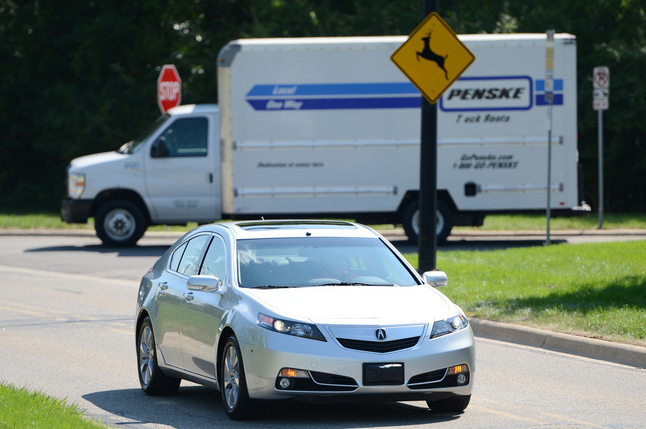
A vehicle equipped with Wi-Fi-like technology drives through a scenario at the University of Michigan Transportation Research Institute in Ann Arbor, Mich. on August 20, 2012.
Melanie Maxwell I AnnArbor.com
Right now roughly 2,000 cars and another 400 trucks and service vehicles are equipped with vehicle-to-vehicle wireless communication devices —dubbed V2V technology,— along with several intersections, curved roads and highway sites.
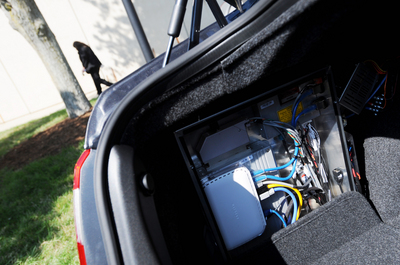
V2V wireless devices installed in a car participating in the study.
The cars have the ability to interact with one another and with devices on roadways so drivers are alerted of safety threats, traffic issues and suggested route changes due to the two.
The vehicles are part of an $18 million real-world deployment of still-developing wireless technology on the roadway. Researchers at the University of Michigan Transportation Research Institute and officials at U.S. Department of Transportation are collecting data from the study to determine if the technology is reliable and effective at reducing collisions.
Starting in January UMTRI will begin deploying bicycles equipped with wireless technology, and in the spring the institute will deploy V2V motorcycles.
Researchers are looking to deploy at least 12 motorcycles and about three bicycles.
The study launched in August.
More volunteers needed
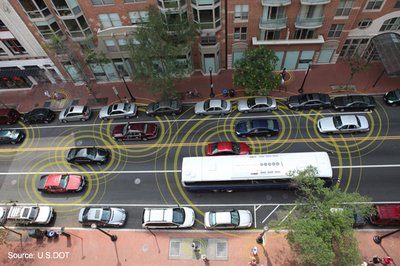
Researchers say connected vehicles can help to mitigate crashes on busy urban streets.
USDOT photo
Researchers are looking to sign up another 400 volunteers willing to equip their car with the technology by the end of November.
Although 4,000 people signed up to volunteer, only 2,000 followed through or were eligible for the study. Deployment manager Jim Sayer said that many who signed up didn't want to deal with the time commitment required, which is roughly three hours spread over the course of nearly a year.
To volunteer, drivers need to frequent the northeast Ann Arbor area. The commitment requires five visits to UMTRI's headquarters at the North Campus Research Complex —one 75-minute visit for installation, three 10-minute visits for data transfer and another visit to extract the device at the end of the study.
Volunteers get $200, which they can pocket or donate to Ann Arbor Public Schools or the Mott Children's Hospital.
If UMTRI doesn't enroll another 400 vehicles, "we will fail to met our sponsor's objectives," said Sayer. USDOT, the project's sponsor, is looking to the deployment as officials consider requiring V2V systems in future vehicles.
Sayer says thus far the V2V-equipped vehicles and infrastructure have been working as expected, alerting drivers of nearby vehicles and safety threats.
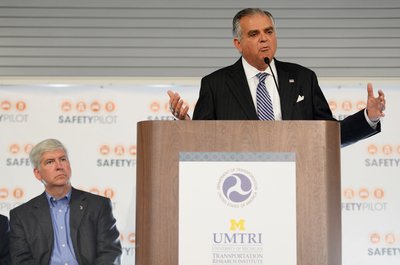
U.S. Secretary of Transportation Ray LaHood speaks as Michigan Gov. Rick Snyder looks on at the launch of a vehicle-to-vehicle communication project in Ann Arbor in August.
Melanie Maxwell | AnnArbor.com
"We've got all of the infrastructure in place, everything is working well. We just need some more personal vehicles," he said.
Ann Arbor becoming hub for V2V research?
When DOT tapped U-M to run the model deployment —UMTRI bid against a number of other prominent research universities for the multimillion research grant— Kirk T. Steudle, director of the Michigan Department of Transportation, predicted that other companies would come to Ann Arbor to test their own wireless technologies, making the area a hub for V2V innovation.
"This area becomes the epicenter of connected vehicle research," he said at the time.
U-M Vice President for Research Stephen Forrest said the Ann Arbor-area had the potential to become the next Silicon Valley.
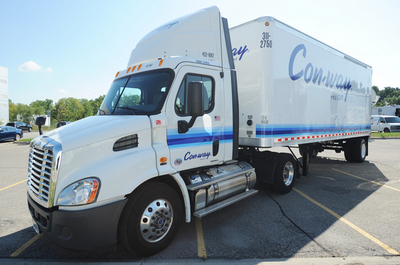
A truck equipped with V2V technology.
"I see our region as poised to be the next really substantial, integrated, industrial core of this nation," Forrest told AnnArbor.com in October.
Sayer said companies are already coming to Ann Arbor to test their devices within the deployment area.
Thus far at least three automobile makers have tested their vehicles in northeast Ann Arbor. Although these vehicles aren't officially related to the study, their V2V technology communicates with the infrastructure and 2,400 vehicles that are currently a part of the study.
Sayer declined to say which auto companies are testing their technology in Ann Arbor.
A handful of telecommunications companies have also approached Sayer about incorporating their technology into the study. These companies are interested in integrating applications that can work on the existing V2V infrastructure and the everyday mobile devices that people already carry with them.
No companies, however, have set up offices in Ann Arbor.
"We want to try to generate business and attract people to this part of Washtenaw County to do this kind of work, and we're having some success," said Sayer. "People aren't moving businesses here yet, but they're at least coming to utilize the facility."
Kellie Woodhouse covers higher education for AnnArbor.com. Reach her at kelliewoodhouse@annarbor.com or 734-623-4602 and follow her on twitter.